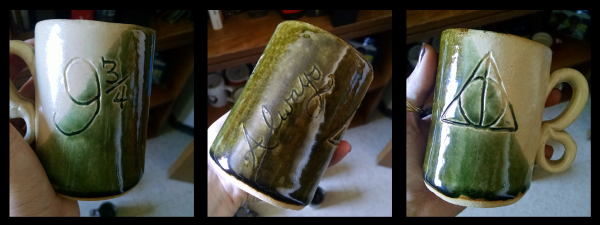First of all, taking a ceramics class in no way fulfilled a requirement for me. I couldn’t find any classes I needed and felt bad taking only one credit over J-Term. I saw “ceramics” and “participation grade” and thought, Hey, I was pretty good at Play-Dough when I was little. How hard can ceramics be?

Plus you get to make Harry Potter themed stuff. In class. For a grade. You can’t turn that down, right?
Hard. That’s the answer.
You know how there are certain people who you see from a distance and you think, I should be friends with them. They seem great. And then when you’re with them you realise that you have nothing in common, all their habits irritate you, their life choices and fashion choices and literature choices all rub you the wrong way, and you start thinking, Wow. I should get an award for not stabbing this human with a fork…
Clay is like those people.
It is not as malleable as Play-Dough. It’s gritty and stiff. It’s not even pretty colours like Play-Dough–it’s grey. It sucks the moisture out of your skin, leaves muddy patches anywhere it touches, and crowds up under your fingernails. If you mess up with Play-Dough or decide halfway through making a small Play-Dough house that you’d rather make a Play-Dough snowman, you can smash it all and start over. With clay, if you smash it and start over, you get air bubbles. If you get air bubbles, the stuff you make can explode in the kiln.
Explode.
(“I’ve only had one student’s work blow up in the kiln,” the professor assures us.
With my luck, I’ll be the second, I think.)
Clay requires patience. In order to make even a simple piece, you first roll your clay out into slabs or press it through an extruder into coils.
(“I’ve only had one student seriously damage a finger in this machine,” the professor explains.
With my luck, I’ll be the second, I think.)
You painstakingly shape every detail of your piece, and you go back over it about a hundred million times to smooth it out, because wet clay takes on the texture of anything that touches it, from your fingernail to that sleeve you brushed up against it accidentally.
(“There’s no cleanup faerie to smooth your piece if you don’t do it,” the professor reminds us.
I’m making it worse trying to fix it, I think.)
Then the clay dries. This takes at least a few days. You sand all the rough spots and indentations and oopses. After that, the piece gets bisque fired. When it comes out, you wax the bottom, fix any leftover rough spots, brush out the inside, dampen the clay, and glaze the piece. Glazing is another multiple-step process that requires forethought and patience. Besides that, the colours the glazes look in the bucket are dramatically different from how they look after firing. For a visual person (pick me!) this makes it extremely difficult. You have to make your plan, dip the pieces, and trust that the glaze really will turn out the colour it’s supposed to.
And did I mention that things can blow up in the kiln?
In a normal class, if I write a truly horrible paper, the professor marks it down. Nobody else ever has to know. In ceramics, if I make a truly horrible piece, everyone watches me work on it. They see it drying on the shelf. They see me sanding and glazing it. And then they see it when it’s done.
And things can blow up.
No matter how badly I write, my essays never blow up.
Writing an essay is a significantly shorter process than handbuilding. I can scrap it and start over, I can edit to my heart’s delight, and nothing blows up. I can rush it if I want to. I can skip a step in the process without fearing for my life doing any real damage. Patience and I are also not the best of friends. Spending twenty minutes on a single half-inch coil frustrates me. Rubbing my thumb over the same bump in the clay for five minutes feels like torture. I’ve heard people talk about how handbuilding is therapeutic. How it’s a slow process, the same motion over and over, repetitive and magical…I just place the emphasis on slow and repetitive and never mind magical. By the time I’ve done an inch of a pot, I’ve decided I don’t want to do this pot anymore; I’d much rather make a bowl. But I have to keep going.

The process looks something like this: (1) wet clay with questionable markings, (2) dry clay with still questionable markings, (3) wonky powdery clay with almost-obliterated markings, (4) BAM THE GLAZE IS MAGIC LOOK AT THAT.
And I can’t just start and stop when I want–starting requires preparation and stopping requires preparation. You can’t jump in and out; you have to wrap your clay in wet paper towels and bags, make sure it’s not bent in funny ways or too dry or flopped all over. You have to clean up and take care of your discarded clay and wash your hands.
There’s something beautiful about that, though–something I don’t notice at the time but start to realise once I’ve seen that my pieces didn’t actually explode or turn into horrific monstrosities. There’s something a bit magical about taking the dried, discarded lumps and chunks that didn’t fit into the piece and putting them in a bucket–about knowing that they’ll turn back into clay that you can roll out again and form into some other piece of art–an endless cycle of using and reusing. There’s no waste in handbuilding.
Clay’s kinda like people, I start to think. Deceptively rough and stiff but deeply impressionable, requiring time and patience, commitment and trust. Clay and people need dedication at every point in the process; you can’t rush the beginning because the end is more exciting. You can’t skimp in the middle and hope nobody notices. And you can’t see the final product until it arrives. People and clay are unpredictable. You have to trust that they’re unique art that will come out of the kiln gleaming and breathtaking, no matter how they look right now.
And in the end, there’s something beautiful about taking dedicating a few hours of my life to forming clay into a shape that I sort of like. There’s something to having nightmares about my pot breaking and then seeing it whole and complete. There’s something to worrying and fretting and poking and scraping and despairing–and then seeing that the stuff I spent so much anxiety on actually turned out kind of okay, and it might not be professional, and maybe I won’t be the next great potter, and maybe I’m too impatient for clay, and maybe I press too hard, and maybe I’m not as artistic as other people…but in the end, nothing exploded.
And in the end, there’s something useful and kinda beautiful in the world–something that wasn’t there before I sat down and started rolling and pressing and poking at some lumps of grey mud.






